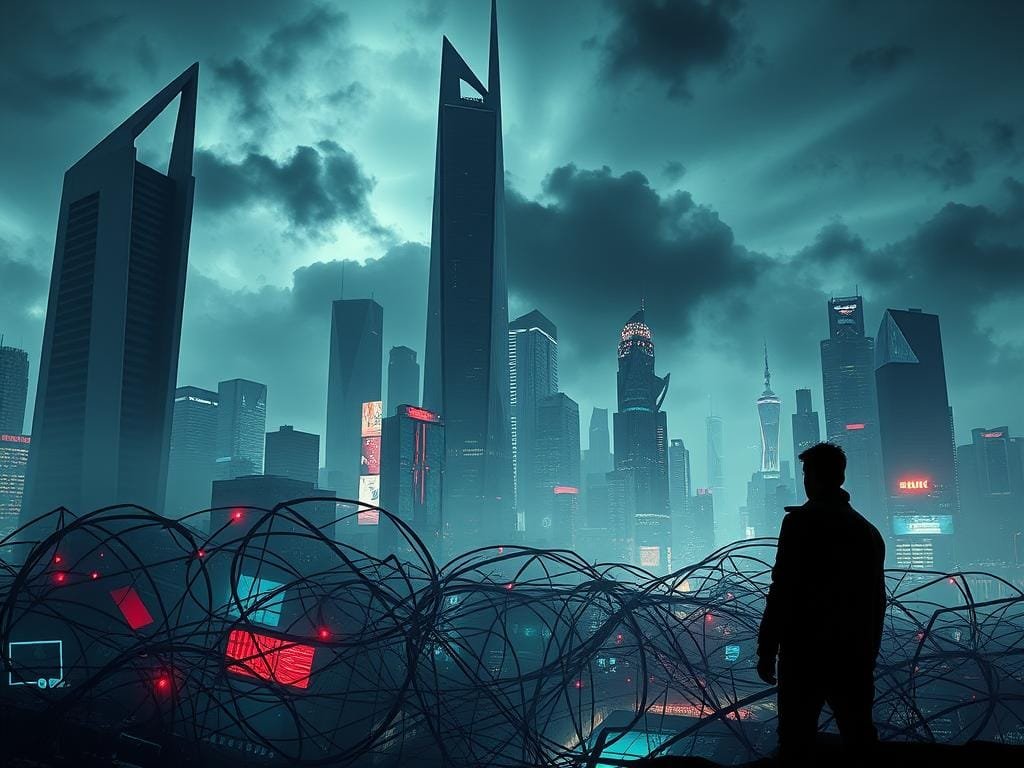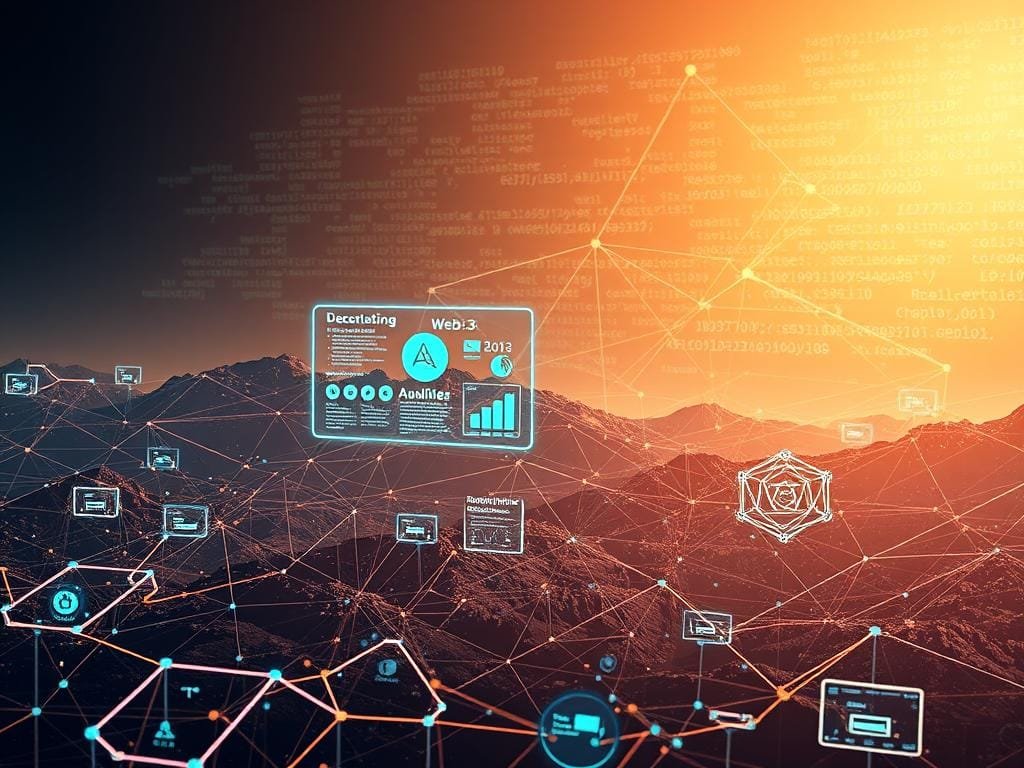The internet is on the cusp of a revolution. Decentralized technologies are set to change how we interact online.
Did you know the current internet, Web2, is open to data breaches and censorship? On the other hand, blockchain technology offers a safer and more open experience. It lets you control your data.
The move towards a decentralized internet is picking up speed. It’s driven by the need for better security and more user control. As you learn about Web2’s limits, the appeal of a decentralized internet grows.
Key Takeaways
- The decentralized internet, or Web3, offers a more secure and transparent online experience.
- Blockchain technology is the backbone of the decentralized web.
- Adopting decentralized technologies can give you greater control over your data.
- The shift towards decentralization is driven by the need for security and user autonomy.
- Understanding Web3 is key for navigating the future of the internet.
Understanding Web3: The Future of the Internet
Web3 is a big change in how we use the internet. It focuses on giving you more control and making things more open. This isn’t just a small update. It’s a big change in how the internet works.
What Is Web3?
Web3 is the next big thing in the internet world. It uses decentralization and blockchain technology to give you more power over your online life. With blockchain and smart contracts, it aims to make the internet safer and more open.
Key Features of Web3
Web3 has some key features that make it special:
- Decentralization: It’s built on a network that’s not controlled by one person or group. This makes it stronger and less likely to be censored.
- Blockchain Technology: This is the heart of Web3. It makes sure transactions are safe, open, and can’t be changed.
- Smart Contracts: These are like self-running contracts. They make sure things happen as agreed, without needing a middleman.
Comparing Web3 to Web2
Web3 is a big step away from Web2. Web2 is all about big companies controlling the internet. Web3 is about you being in charge. Here’s how they differ:
- Data Ownership: In Web2, companies own your data. In Web3, you do.
- Security: Web3 uses blockchain and smart contracts to keep things safe. Web2 is more vulnerable.
- User Experience: Web3 offers a more personal and secure experience. It’s all about you.
Why Decentralization Matters
The move towards a decentralized internet is more than a trend. It’s a must for keeping your online security and privacy safe. As you explore the digital world, knowing why decentralization is key is vital.
Decentralization gives you more control over your digital stuff. It spreads data across a network, not just one spot. This helps avoid big problems like data breaches and unauthorized access.
User Control
One big plus of decentralization is more user control over your data. In a decentralized setup, you decide how your data is shared and used. This makes your online life more personal and secure.
For example, dApps let you use services without giving up your data. a16zcrypto says decentralization lets users control their digital world better.

Enhanced Privacy and Security
Decentralization boosts privacy and security a lot. It spreads data, making it hard for bad guys to get to it. This is super important for digital assets, where keeping things safe is a top priority.
Also, decentralized systems use top-notch crypto to keep data safe. As you dive into Web3, knowing these security steps is key to protecting your digital stuff.
The Role of Blockchain in Web3
At the heart of Web3 is blockchain technology. It ensures transparency, security, and decentralization. Blockchain is more than just cryptocurrency. It’s a technology for secure, transparent, and decentralized transactions.
Introduction to Blockchain Technology
Blockchain technology is a system that records transactions on a network of computers. It’s decentralized, so no single entity controls the data. This makes it resistant to censorship and fraud.
The network operates peer-to-peer, cutting out intermediaries. This speeds up transactions and lowers costs. Ethereum is a popular platform for creating decentralized apps and smart contracts.
Popular Use Cases of Blockchain
Blockchain is not just for cryptocurrency. It’s used in supply chain management, healthcare, and voting systems. It helps track goods, store medical records securely, and ensure election integrity.
- Supply Chain Management: Enhancing transparency and traceability.
- Healthcare: Securely storing medical records.
- Voting Systems: Ensuring election integrity.
How Blockchain Supports Decentralization
Blockchain is key to decentralization in Web3. It enables decentralized applications (dApps) and smart contracts. This creates a digital ecosystem not controlled by one entity.
Blockchain also supports digital assets like non-fungible tokens (NFTs) and cryptocurrencies. These can be traded on decentralized marketplaces. This opens up new economic opportunities and makes the internet more open and inclusive.
Tokenization and Digital Assets
Tokenization is changing the internet, making it more decentralized. It turns assets into digital tokens on a blockchain. This changes how we own and transfer value online.

Cryptocurrencies: The Pioneer Digital Asset
Cryptocurrencies like Bitcoin and Ethereum are pioneers in digital assets. They use blockchain for secure, decentralized transactions. This means no banks are needed.
Key characteristics of cryptocurrencies include:
- Decentralized control, meaning no single entity controls the network.
- Security through cryptographic algorithms that protect transactions.
- Transparency, as all transactions are recorded on a public ledger.
Andreas Antonopoulos says, “Bitcoin is the first and most well-known example of a decentralized cryptocurrency.” This shows how cryptocurrencies lead in digital assets.
NFTs: More Than Just Digital Art
NFTs are a big deal in tokenization. They are unique and can’t be swapped like other digital assets. They show ownership of digital art, collectibles, and real-world items.
| Feature | Cryptocurrencies | NFTs |
|---|---|---|
| Fungibility | High | Low |
| Primary Use | Transactions, Store of Value | Representing Ownership, Digital Art |
NFTs are perfect for digital art and collectibles because they are unique. As Web3 grows, NFTs will likely play a bigger role in digital assets.
In summary, tokenization is key to Web3. It lets us create different digital assets like cryptocurrencies and NFTs. These assets change how we think about ownership and transactions. They also open up new economic models and chances for creators and investors.
The Importance of User-Centric Design in Web3
The move to Web3 is more than just new tech. It’s about making you, the user, the main focus. As we move to a more decentralized internet, design that puts you first is key to the future of online interactions.
Empowering Users
User-centric design in Web3 means empowering you to control your data and online experiences. Unlike Web2, where big companies control your data, Web3 lets you manage your identity and data easily. This makes your online life more private and personal.
For example, dApps on Web3 platforms let you use different services without making many accounts or sharing personal info. This easy experience comes from design that puts you first.
Community Governance Models
Another big part of Web3 is community governance models. These models let users like you help decide how projects grow. This makes sure projects match what the community wants.
With DAOs (Decentralized Autonomous Organizations), you can vote on big decisions. This way, you help shape the project’s future. It makes things more open and makes sure everyone’s voice is heard.
For instance, in a DAO, you can vote on things like how money is spent or changes to the protocol. This way of making decisions is a big part of Web3’s focus on decentralization and putting users first.
As Web3 keeps growing, the role of design that focuses on you and community governance will get even bigger. Web3 is set to change how we use the internet, making it more open, fair, and powerful for everyone.
Current Challenges Facing Web3
Web3 faces many hurdles, like scalability problems and unclear rules. It’s key to grasp these issues to see if Web3 can really take off.

Scalability Issues
Scalability is a big problem for Web3. Blockchain tech, Web3’s core, is struggling to grow. Many blockchains can’t handle lots of transactions at once, causing delays and high costs.
The Ethereum network, a Web3 leader, has seen these issues. It’s working on fixes like Optimism and Polygon to improve.
Many solutions are being looked into, like sharding and second-layer tech. These aim to boost blockchain speed without losing decentralization. As the state of Web3 in 2024 shows, new fixes are coming.
“Scalability is one of the most significant technical challenges facing blockchain and Web3 today,” notes an expert in the field. “Overcoming this will be key for Web3 to become mainstream.”
Regulatory Concerns
Web3 also faces unclear rules. Governments worldwide are figuring out how to manage blockchain and crypto. This uncertainty makes it hard for developers and users.
Regulations for Web3 vary a lot, with some places more open than others. This makes it tough to build and use Web3 apps globally. Stable and clear rules are needed to help Web3 grow.
- Clear rules can spark innovation.
- Uncertainty can slow Web3’s growth.
- Global cooperation is key for unified rules.
As Web3 grows, solving these problems is vital. Tackling scalability and regulatory issues will help shape the decentralized internet’s future.
The Transition from Web2 to Web3
Understanding the shift from Web2 to Web3 is key for your business’s success. The internet is becoming more decentralized. This change affects how businesses work and interact with customers.
What Businesses Need to Know
The move to Web3 changes how data is handled. Decentralized technologies, like blockchain, bring better security and user control. Businesses must grasp the power of these tools to open new doors or enhance current operations.
Another important point is digital assets and their tokenization. This can lead to new income sources and customer engagement. Yet, it demands a solid grasp of regulations and the tech needed to support these assets.
Steps to Adapt to Web3
To fit into the Web3 world, start by learning about the key technologies. This means getting to know blockchain technology and its uses. Also, understand decentralization and its role in data security and management.
- Look at your current tech setup and see where Web3 can fit in.
- Plan how to adopt decentralized tech, weighing the pros and cons.
- Connect with the Web3 community to keep up with new trends and tips.
By following these steps, your business can excel in the Web3 era. You’ll use decentralization’s advantages while tackling its hurdles.
Real-World Applications of Web3
Web3 is growing fast, changing how we use money and play games online. It’s making our digital world more open and secure. You’re part of a big group exploring this new internet.
Decentralized Finance (DeFi)
DeFi is a big part of Web3, bringing new financial services without banks. DeFi protocols let you lend, borrow, and trade on blockchain. This makes things more open and easy to use.
DeFi has many platforms, like lending sites (e.g., Compound) and stablecoins (e.g., DAI). These work on Ethereum and are getting popular fast.
| DeFi Platform | Function | Blockchain |
|---|---|---|
| Compound | Lending Protocol | Ethereum |
| Uniswap | Decentralized Exchange | Ethereum |
| MakerDAO | Stablecoin Issuance | Ethereum |
Web3 in Gaming and Entertainment
Web3 is changing games and entertainment by giving power to creators and players. NFTs (Non-Fungible Tokens) let people own digital things like art and game items.
Gaming is using Web3 to create new ways to earn and play. Players can trade and buy things in a new way. This makes games more fun and helps developers make money.

Exploring Web3 shows its big impact on DeFi and gaming. But it’s just starting. Web3 will change many parts of our digital lives, making them safer and more open.
The Future of Work with Web3
Web3 is changing the world of work. It brings decentralized structures that help both workers and businesses. We need to see how Web3 brings new ways of working and teaming up.
Remote Work and Decentralized Workforces
Remote work is evolving with Web3. Now, businesses can hire from all over the world. This is thanks to blockchain technology, which makes it safe and efficient.
New Business Models Emerging
Web3 is creating new business models. For example, DAOs (Decentralized Autonomous Organizations) are changing how companies make decisions. They offer a more democratic and open way to run businesses.
| Business Model | Description | Benefits |
|---|---|---|
| Decentralized Autonomous Organizations (DAOs) | Organizations that operate on blockchain technology, allowing for decentralized decision-making. | More democratic, transparent, and inclusive. |
| Crowdsourced Projects | Projects that rely on contributions from a global community, often incentivized through tokens. | Taps into global talent, fosters innovation. |
| Remote Work Platforms | Platforms that connect businesses with remote workers, often using blockchain for secure payments. | Increases flexibility, reduces geographical constraints. |
In conclusion, Web3 is changing the future of work. It brings more flexible, autonomous, and decentralized work options. As new models appear, it’s key for businesses and workers to adjust and succeed in this new world.
Getting Started with Web3
Now that you know about Web3’s power, it’s time to start. You can begin by checking out learning resources. They offer detailed guides on Web3 development and its uses.
Educational Content
There are many online courses and tutorials out there. They cover blockchain tech, cryptocurrencies, and decentralized apps. These resources will deepen your understanding of Web3 ecosystems.
Initial Steps
To dive into Web3, first set up a digital wallet. It’s key for using blockchain-based apps. Then, explore DeFi platforms, NFT marketplaces, and other Web3 apps. This will let you see the decentralized internet in action.
As you keep learning, you’ll find out more about Web3’s chances and hurdles. This knowledge will help you make smart choices about getting involved in this new tech.
FAQ
What is Web3 and how does it differ from Web2?
Web3 is a new version of the internet, built on blockchain. It’s more secure and open. Unlike Web2, which is controlled by big companies, Web3 lets users control their data.
What is decentralization, and why is it important?
Decentralization means power and data are spread out, not in one place. It makes the internet safer and more private. It’s key because it reduces risks and makes the internet more free.
How does blockchain technology support Web3?
Blockchain is the core of Web3, making data safe and clear. It helps create apps without a central point, and supports digital assets. This makes Web3 decentralized and secure.
What are cryptocurrencies and NFTs, and how are they used in Web3?
Cryptocurrencies are digital money for safe transactions. NFTs are unique digital items, like art. Both are used in Web3 for new ways to make money and own things.
What is user-centric design in Web3, and why is it important?
User-centric design in Web3 puts users first, giving them control over their data. It’s important because it makes the internet fairer and more fun for everyone.
What are the current challenges facing Web3, and how are they being addressed?
Web3 faces issues like growing too big and dealing with rules. To solve these, people are working on making blockchain faster and creating rules for Web3.
How can businesses transition from Web2 to Web3?
Businesses can move to Web3 by understanding decentralization and new ways to connect with people. They need to learn about blockchain and new economic models.
What are some real-world applications of Web3?
Web3 is used in finance, games, and entertainment. It’s changing how we do banking and enjoy games and movies.
How can I get started with Web3?
Start with Web3 by learning about blockchain, setting up a digital wallet, and trying out apps. You can find tutorials online and join Web3 communities to learn by doing.
What is the future of work in a Web3 world?
In Web3, work will be more flexible and remote, thanks to blockchain. New jobs and ways to work will emerge, giving people more freedom and chances to earn.
